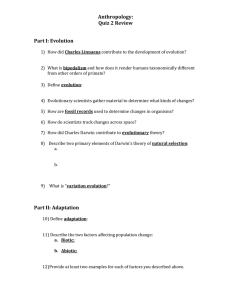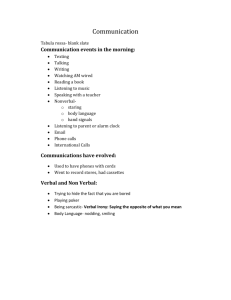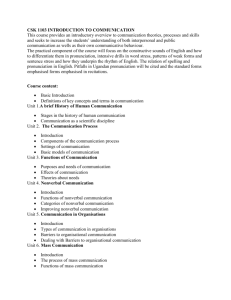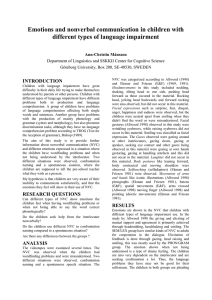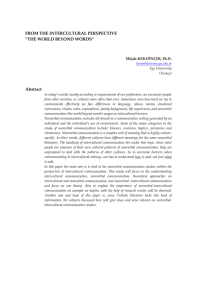AnthroQuiz2ReviewKey
advertisement
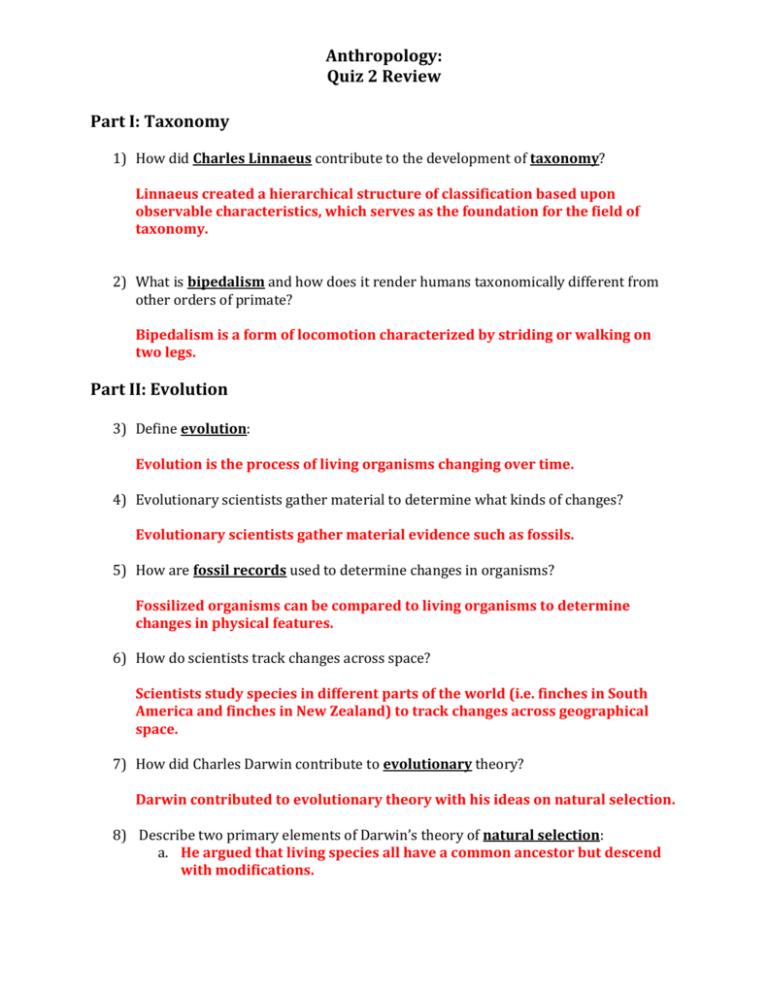
Anthropology: Quiz 2 Review Part I: Taxonomy 1) How did Charles Linnaeus contribute to the development of taxonomy? Linnaeus created a hierarchical structure of classification based upon observable characteristics, which serves as the foundation for the field of taxonomy. 2) What is bipedalism and how does it render humans taxonomically different from other orders of primate? Bipedalism is a form of locomotion characterized by striding or walking on two legs. Part II: Evolution 3) Define evolution: Evolution is the process of living organisms changing over time. 4) Evolutionary scientists gather material to determine what kinds of changes? Evolutionary scientists gather material evidence such as fossils. 5) How are fossil records used to determine changes in organisms? Fossilized organisms can be compared to living organisms to determine changes in physical features. 6) How do scientists track changes across space? Scientists study species in different parts of the world (i.e. finches in South America and finches in New Zealand) to track changes across geographical space. 7) How did Charles Darwin contribute to evolutionary theory? Darwin contributed to evolutionary theory with his ideas on natural selection. 8) Describe two primary elements of Darwin’s theory of natural selection: a. He argued that living species all have a common ancestor but descend with modifications. b. Those that are “more fit” survive and produce more offspring. 9) What is “variation evolution?” Variation evolution occurs when there is a genetic mutation and individuals who are best suited to the environment thrive. Part III: Adaptation 10)Describe the six factors that can change a population: a. Competition b. Predation c. Migration d. Disease e. Natural disasters f. War 11)Define adaptation: Adaptation describes how plants and animals are able to survive in various environments. 12)Identify three resources over which animals struggle for survival: a. Food b. Water c. Protection against predators (Additional options: protection against weather, disease, and accidents) 13) Describe the two types of adaptation: a. Structural: changes in the physical features of plants and animals that help them to better overcome the challenges of their environment. b. Behavioral: changes made based on observation and necessity in order to survive. Part IV: Language (Verbal, Nonverbal, and Code-Switching) 14) Briefly describe the difference between speech, language, and communication. Speech: The physical, verbal formation of words. Language: The conveyance/expression of meaning. Communication: Interactions that are verbal and nonverbal. 15) Define nonverbal communication: Communicating without the use of words. 16) Describe the four properties of nonverbal communication: a. Universality – Some forms of NVC are common everywhere. b. Simultaneity – NVC messages can occur at the same time. c. Spontaneity – NVC can occur mindlessly and automatically. d. Iconicity – NVC signs may resemble their referents. 17)Describe the four functions of nonverbal communication: a. Identification: Signaling individuality, gender, age, ethnicity, personality, group membership; communicated primarily through physical appearance. b. Relationship: Signaling the two dimensions of relationships -- intimacy and control; communicated primarily through gaze, touch, and proximity (i.e., contact codes). c. Emotion: Signaling basic emotional states and expressing social intentions; communicated primarily through facial expressions and also vocal expressions. d. Delivery: Conveying verbal messages primarily through voice and gestures; nonverbal channels can support, modify, and replace spoken messages. 18)Briefly describe code-switching: Code switching occurs when someone alternates their language choices -vocabulary, tone, style, pitch, etc., -- when in different settings or even within the same setting. Potential Short Answer Questions: 19) Justify the argument that language is the most significant evolutionary feature of human development. Language may very well be the most significant evolutionary feature of human development because it has propelled human interaction to very complex levels of coordination, compromise, and collaboration. Humans have developed a global society by communicating goals, hopes, and intentions in written and verbal forms. (Answers will vary!) 20) Beyond providing statistical evidence, explain how nonverbal communication is arguably more important in human interaction than verbal communication. Nonverbal communication accounts for more than 60% of human communication. Social and cultural norms have developed to account for the intended meanings of NVC characteristics such as facial expressions, gestures, body language, tone, and pitch. The nonverbal cues we send to others often convey more meaning than the words we choose – hence the old parental adage, “It’s not what you said; it’s how you said it!” (Answers will vary!)
